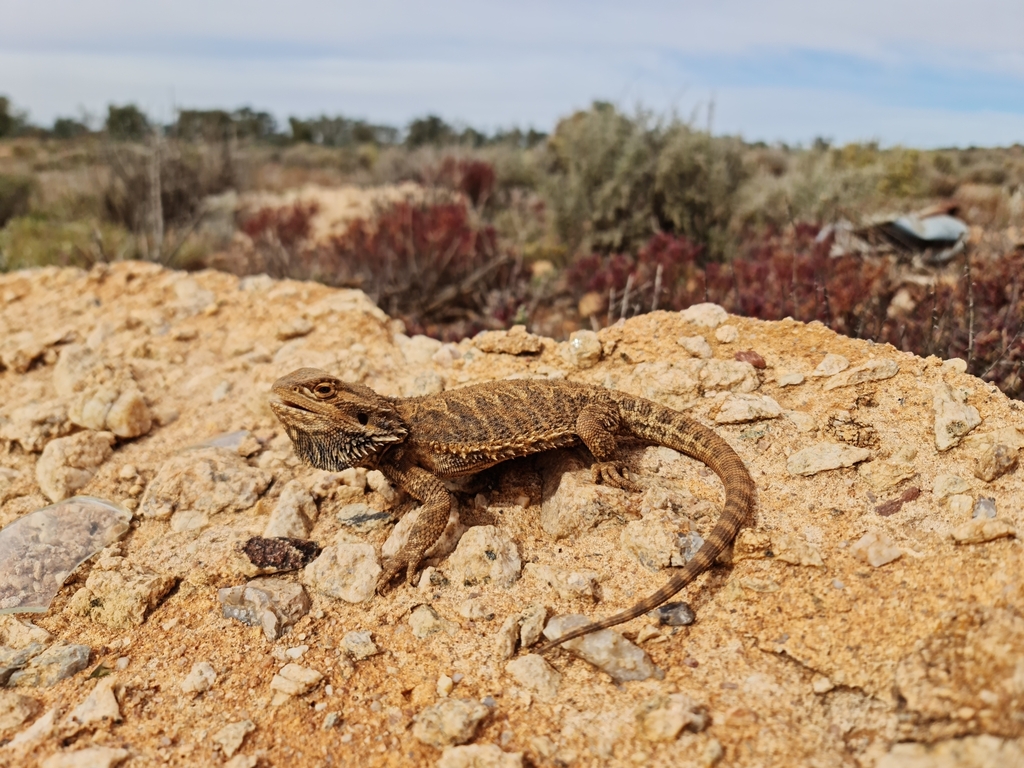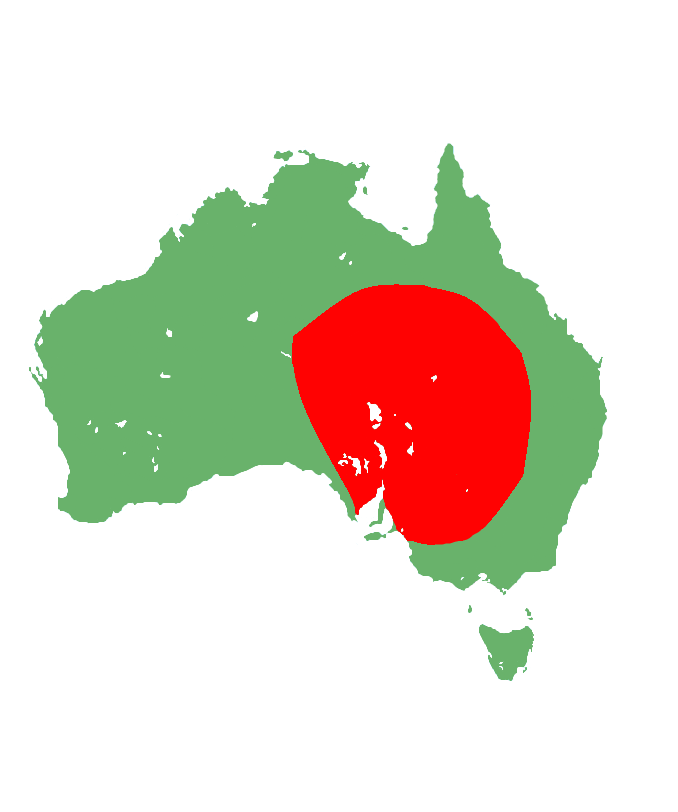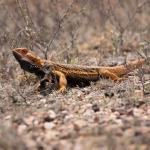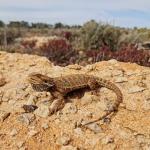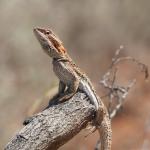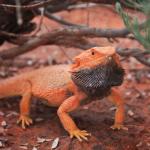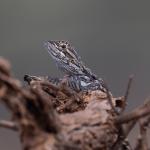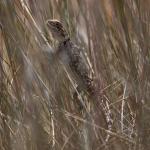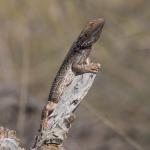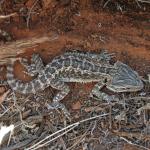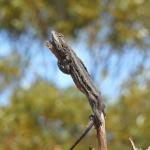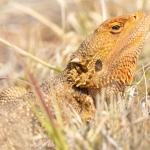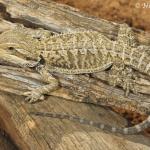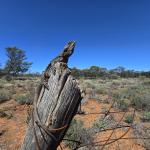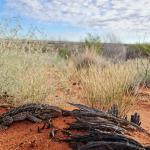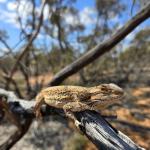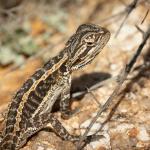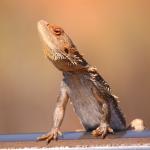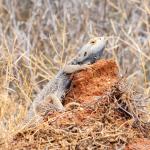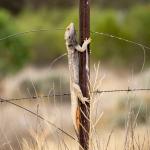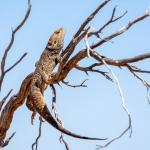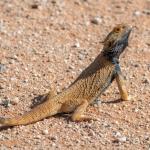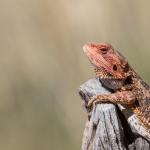- Home
- Herpetofauna Index
- Pogona Vitticeps
Pogona vitticeps
Central bearded dragon
Pogona vitticeps
(Ahl, 1927)

Length: SVL up to 250mm, with a total length of 550mm.
Weight: up to 520 grams
Description
The central bearded dragon is a medium-sized agamid endemic to the arid and semi-arid regions of the interior of eastern Australia. As with all members of the Pogona genus, they are often referred to as ‘beardies’ due to their spine-covered throats which they can inflate as a threat display.
The central bearded dragon, much like other bearded dragons (Pogona spp.) has a squat and flattened build, with a short triangular head, and spike-like protrusions which occur along the sides, cheeks and neck, and at the back of their head. Raised scales also occur along other parts of the body giving them an overall rough appearance. Generally, the species ranges from greyish or cream through to bright orange, but they can darken their skin pigments to dark brown or even black when threatened, although their environment often determines their general colouration. This dark colouration is often concentrated in the throat region during both threat and mating displays. Although often exhibiting subdued patterning as adults, juveniles have intricate patterns, these often consist of two light/bright-coloured diamond chains or stripes running either side of the spine which merge with the contrasting light and dark markings on the top and sides of their heads. In addition to this, they also exhibit a pattern of banding along their tail consisting of light and dark shades of their background colouration, often darkening towards the tail tip.
There is some sexual dimorphism between males and females, with males being slightly larger, having larger heads, and often exhibiting a brighter colouration.
Central bearded dragons can be differentiated from the eastern bearded dragon (the other captive species of Pogona in NZ) by the colour of their mouth lining (reddish-pink vs. bright yellow), their wider variety of colours (including various shades of oranges, and yellows vs. primarily grey), their smaller size, and differences in scalation (e.g. more prominent spines).
Life expectancy
Captive individuals have been known to reach ages of around 20 years, however, in the wild their life expectancy is much lower with long-lived individuals estimated to live around 12 years.
Distribution
Should not occur in the wild in New Zealand (please report to MPI if located).
Arid and semi-arid woodlands, and rocky deserts of eastern inland Australia. Occurring in the eastern regions of the Northern Territory and South Australia, and the western regions of Queensland and New South Wales, their range also encroaches slightly into northwestern Victoria.
Ecology and habitat
The central bearded dragon is a diurnal species of agamid which occurs within the arid and semi-arid woodlands and rocky deserts of eastern inland Australia. They have semi-arboreal tendencies and can often be found basking on branches, in bushes, or on fence posts. Being a medium-sized lizard, central bearded dragons sit within the middle of the food web and are prey for many large birds, mammals, and reptiles. As such, they possess a unique defensive display in which they rapidly inflate their body and throat (which they oftentimes change to black) whilst their mouth gaping, this gives them a much larger and spiky appearance which may deter would-be predators.
Social structure
Central bearded dragons are solitary, but often form aggregations in areas where suitable basking sites are limited. This often leads to social interactions, where animals assert their dominance or submissiveness through various body language cues including head bobbing and arm waving. During the breeding season, males also interact in this way to secure mating rights, although fighting may break out if they are evenly matched.
Breeding biology
Central bearded dragons, as with other agamids are oviparous (egg-laying). Mating occurs in Spring (September to November) with males engaging in territorial displays for the right to mate. Females express their responsiveness to dominant males by doing an arm wave in conjunction with a slow head bob. This courtship display comes to its conclusion when the male with its darkened throat begins circling the female, after which vigorous body bobbing ensues followed by copulation (which involves neck biting). Sometime after mating, typically around mid-late Spring females excavate a burrow to deposit a clutch of 11-30 eggs, after which the female backfills the nest. In captivity, females have been recorded as having up to four clutches in a season. Several incubation factors seem to determine when neonates hatch from their eggs, but hatching typically occurs 50-80 days after they are deposited. Upon hatching, neonates have an egg tooth and are about 38mm in SVL. Sexual maturity is reached between 1 and 2 years, but this is more closely aligned with body condition rather than age.
Diet
The central bearded dragon is an omnivorous species. Generally, their diet is comprised of about 60% plant matter and 40% animal matter by volume, but this varies by season. They are fairly opportunistic with studies indicating that seasonal food sources, such as harvester termites (Drepanotermes spp.) and particularly their alates (winged progeny), can essentially become their primary prey (up to 95% of prey items taken). Being an opportunistic species they have been recorded feeding on a wide variety of plants and animals including small lizards and mammals, although they are primarily insectivorous when it comes to their prey items.
Disease
The central bearded dragon is susceptible to many of the same diseases related to poor husbandry (e.g. MBD, impaction, etc.) that other captive reptiles in New Zealand can develop.
Conservation
Central bearded dragons are listed as ‘Not Threatened’ by the IUCN
Interesting notes
The genus name Pogona is derived from the Greek word for beard, referring to the spiked and inflatable throats of this genus. The species name vitticeps is derived from the Latin words for ribbon/band and head, possibly referring to the pattern of spines on their head.
Like some other lizard species, bearded dragons have been shown to exhibit colour change with the day-night cycle. During the day they darken their skin, whilst at night they have lighter pigmentation.
Sex reversal can occur during incubation if male eggs are exposed to high temperatures. Although genetically male these individuals present as female as they mature, and are fertile. When young they present as male but do not progress to develop the larger head of typical males.

